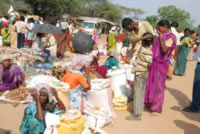Table 1. Land Use Pattern
Details |
Minjur (Tamil Nadu) |
Gumma (Orissa) |
Mawphlang(Meghalaya) |
|
Area (ha) |
Percent to total |
Area (ha) |
Percent to total |
Area
(ha) |
Percent to total |
Agriculture-Irrigated |
294 |
30.56 |
481 |
8.00 |
128 |
4.96 |
Agriculture
Rain fed |
359 |
37.32 |
1653 |
27.47 |
1760 |
68.32 |
Common lands (grazing, forests etc) |
265 |
27.55 |
3860 |
64.15* |
682 |
26.47 |
Water Bodies |
44 |
4.57 |
23 |
0.38 |
6 |
0.25 |
Total Area |
962 |
|
6017 |
|
2576 |
|
|
Note: Much of the horticulture in Gumma is in the designated forestlands. Moreover, collection of Non-Timber Forest Products is an important occupation in Gumma |
 Analysis of the land use pattern in these three locations clearly revealed the dominance of rain-fed agriculture, largely in Mawphlang and to a reasonable extent in Gumma. Lack of water for irrigation, therefore sets the limits for improving productivity. Analysis of the land use pattern in these three locations clearly revealed the dominance of rain-fed agriculture, largely in Mawphlang and to a reasonable extent in Gumma. Lack of water for irrigation, therefore sets the limits for improving productivity.
Moreover, the average holding size in all these locations is small (0.5 ha in Minjur; 0.79 ha in Gumma; and 1.05 ha in Mawphlang). Agriculture is not a major priority in Minjur where most of the surveyed villages are coastal and thus are dependent on fishing in the Pulicat lake. Area under commons is significantly high in Gumma and this mostly includes forestlands where people cultivate a large number of horticultural crops and collect non-timber forest products (NTFP).
|


